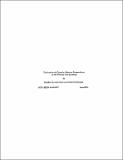| dc.contributor.author | Lautzenhiser, Stephen | en_US |
| dc.contributor.author | MacDonald, Scott Charles | en_US |
| dc.contributor.other | Massachusetts Institute of Technology. Center for Energy and Environmental Policy Research. | en_US |
| dc.date.accessioned | 2009-12-16T00:00:03Z | |
| dc.date.available | 2009-12-16T00:00:03Z | |
| dc.date.issued | 1994 | en_US |
| dc.identifier | 94005 | en_US |
| dc.identifier.uri | http://hdl.handle.net/1721.1/50205 | |
| dc.description.abstract | The purpose of this thesis is to analyze capacity release transactions in the natural gas industry and to state some preliminary conclusions about how the capacity release market is functioning. Given FERC's attempt to enhance market efficiency through the capacity release mechanism, we analyze the development of capacity release from approximately April 1993 through the middle of February 1994. We examine the prices for released capacity and their corresponding terms on two natural gas pipelines, Tennessee Gas Pipeline and El Paso Natural Gas Pipeline. After we explain the capacity release market and identify the factors influencing capacity release prices, we attempt to quantify the importance of these factors through cross-section regression analysis. We perform separate regression analyses for each of the pipelines recognizing the differences in the California and Northeast markets. | en_US |
| dc.description.abstract | We then pool the data to test the hypothesis that the markets are operating in a sufficiently similar manner to validate an integrated-markets understanding of capacity release. Finally we suggest some areas of future study and ways to improve upon our analysis if given sufficient time and resources. The results of our analysis suggest that the market for released capacity that is subject to bidding (i.e. capacity that is posted on electronic bulletin boards for prospective replacement shippers to bid on), is thin. For the two pipelines we analyzed, there appears to be limited competition for capacity release. The price is therefore not being bid up beyond the minimum rate specified by the releasing shipper. Thus, the relevant question in the bidding market segment is how releasing shippers are determining the minimum rate. | en_US |
| dc.description.abstract | Our results suggest a trial-and-error method on the part of firm shippers in the concentrated California market, where firm shippers have lowered their required minimum rates over time. Nonetheless, there are prearranged deals that earn the maximum rate. This suggests that when capacity is scarce, parties are prearranging for capacity release at the maximum value, leaving the residual capacity, with little demand, open to bidding. | en_US |
| dc.description.sponsorship | Supported by the MIT Center for Energy and Environmental Policy Research, and the Environmental Protection Agency under Cooperative Agreement. | en_US |
| dc.format.extent | 58 p., [21] leaves of plates | en_US |
| dc.publisher | MIT Center for Energy and Environmental Policy Research | en_US |
| dc.relation.ispartofseries | MIT-CEEPR (Series) ; 94-005WP. | en_US |
| dc.title | Evaluation of capacity release transactions in the natural gas industry | en_US |
| dc.type | Working Paper | en_US |
| dc.identifier.oclc | 35720833 | en_US |
